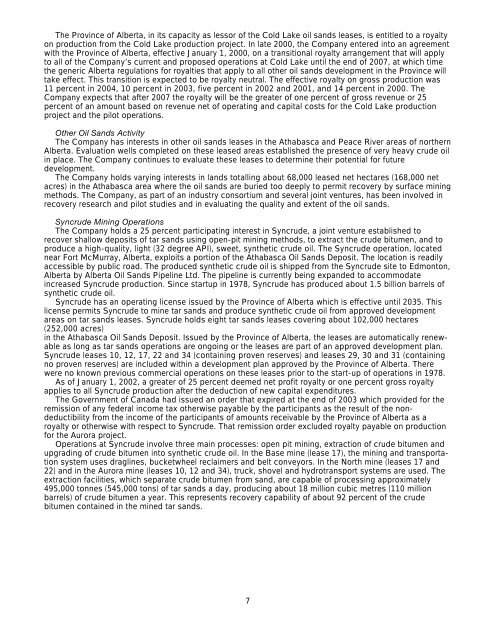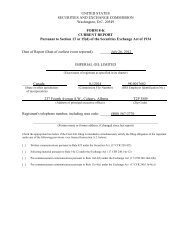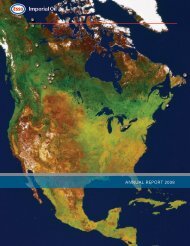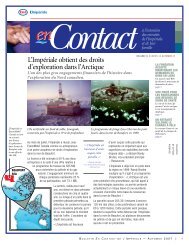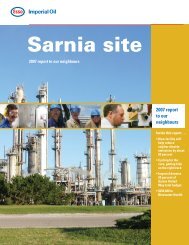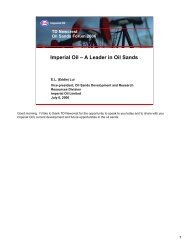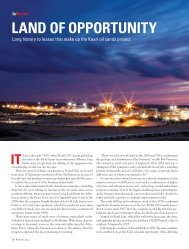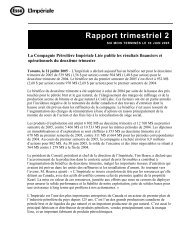FORM 10-K IMPERIAL OIL LIMITED
FORM 10-K IMPERIAL OIL LIMITED
FORM 10-K IMPERIAL OIL LIMITED
You also want an ePaper? Increase the reach of your titles
YUMPU automatically turns print PDFs into web optimized ePapers that Google loves.
The Province of Alberta, in its capacity as lessor of the Cold Lake oil sands leases, is entitled to a royalty<br />
on production from the Cold Lake production project. In late 2000, the Company entered into an agreement<br />
with the Province of Alberta, effective January 1, 2000, on a transitional royalty arrangement that will apply<br />
to all of the Company’s current and proposed operations at Cold Lake until the end of 2007, at which time<br />
the generic Alberta regulations for royalties that apply to all other oil sands development in the Province will<br />
take effect. This transition is expected to be royalty neutral. The effective royalty on gross production was<br />
11 percent in 2004, <strong>10</strong> percent in 2003, five percent in 2002 and 2001, and 14 percent in 2000. The<br />
Company expects that after 2007 the royalty will be the greater of one percent of gross revenue or 25<br />
percent of an amount based on revenue net of operating and capital costs for the Cold Lake production<br />
project and the pilot operations.<br />
Other Oil Sands Activity<br />
The Company has interests in other oil sands leases in the Athabasca and Peace River areas of northern<br />
Alberta. Evaluation wells completed on these leased areas established the presence of very heavy crude oil<br />
in place. The Company continues to evaluate these leases to determine their potential for future<br />
development.<br />
The Company holds varying interests in lands totalling about 68,000 leased net hectares (168,000 net<br />
acres) in the Athabasca area where the oil sands are buried too deeply to permit recovery by surface mining<br />
methods. The Company, as part of an industry consortium and several joint ventures, has been involved in<br />
recovery research and pilot studies and in evaluating the quality and extent of the oil sands.<br />
Syncrude Mining Operations<br />
The Company holds a 25 percent participating interest in Syncrude, a joint venture established to<br />
recover shallow deposits of tar sands using open-pit mining methods, to extract the crude bitumen, and to<br />
produce a high-quality, light (32 degree API), sweet, synthetic crude oil. The Syncrude operation, located<br />
near Fort McMurray, Alberta, exploits a portion of the Athabasca Oil Sands Deposit. The location is readily<br />
accessible by public road. The produced synthetic crude oil is shipped from the Syncrude site to Edmonton,<br />
Alberta by Alberta Oil Sands Pipeline Ltd. The pipeline is currently being expanded to accommodate<br />
increased Syncrude production. Since startup in 1978, Syncrude has produced about 1.5 billion barrels of<br />
synthetic crude oil.<br />
Syncrude has an operating license issued by the Province of Alberta which is effective until 2035. This<br />
license permits Syncrude to mine tar sands and produce synthetic crude oil from approved development<br />
areas on tar sands leases. Syncrude holds eight tar sands leases covering about <strong>10</strong>2,000 hectares<br />
(252,000 acres)<br />
in the Athabasca Oil Sands Deposit. Issued by the Province of Alberta, the leases are automatically renewable<br />
as long as tar sands operations are ongoing or the leases are part of an approved development plan.<br />
Syncrude leases <strong>10</strong>, 12, 17, 22 and 34 (containing proven reserves) and leases 29, 30 and 31 (containing<br />
no proven reserves) are included within a development plan approved by the Province of Alberta. There<br />
were no known previous commercial operations on these leases prior to the start-up of operations in 1978.<br />
As of January 1, 2002, a greater of 25 percent deemed net profit royalty or one percent gross royalty<br />
applies to all Syncrude production after the deduction of new capital expenditures.<br />
The Government of Canada had issued an order that expired at the end of 2003 which provided for the<br />
remission of any federal income tax otherwise payable by the participants as the result of the nondeductibility<br />
from the income of the participants of amounts receivable by the Province of Alberta as a<br />
royalty or otherwise with respect to Syncrude. That remission order excluded royalty payable on production<br />
for the Aurora project.<br />
Operations at Syncrude involve three main processes: open pit mining, extraction of crude bitumen and<br />
upgrading of crude bitumen into synthetic crude oil. In the Base mine (lease 17), the mining and transportation<br />
system uses draglines, bucketwheel reclaimers and belt conveyors. In the North mine (leases 17 and<br />
22) and in the Aurora mine (leases <strong>10</strong>, 12 and 34), truck, shovel and hydrotransport systems are used. The<br />
extraction facilities, which separate crude bitumen from sand, are capable of processing approximately<br />
495,000 tonnes (545,000 tons) of tar sands a day, producing about 18 million cubic metres (1<strong>10</strong> million<br />
barrels) of crude bitumen a year. This represents recovery capability of about 92 percent of the crude<br />
bitumen contained in the mined tar sands.<br />
7


